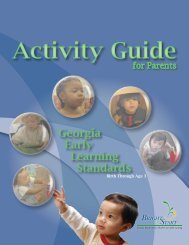Georgia's Pre-K Program - FPG Child Development Institute ...
Georgia's Pre-K Program - FPG Child Development Institute ...
Georgia's Pre-K Program - FPG Child Development Institute ...
Create successful ePaper yourself
Turn your PDF publications into a flip-book with our unique Google optimized e-Paper software.
Findings<br />
Georgia Study of Early Care and Education: Findings from Georgia’s <strong>Pre</strong>-K <strong>Program</strong><br />
Of the 173 programs in the study, 112 were centers and 61 were public schools. Fiftythree<br />
(53) of the 112 centers (47%) participated in Georgia’s <strong>Pre</strong>-K. Because we only<br />
recruited public schools that received Georgia’s <strong>Pre</strong>-K funds, all 61 public schools<br />
in the study participated in Georgia’s <strong>Pre</strong>-K. This report focuses solely on the 114<br />
programs (53 centers and 61 schools) that participated in Georgia’s <strong>Pre</strong>-K <strong>Program</strong>.<br />
Many centers include both regular preschool and Georgia’s <strong>Pre</strong>-K classrooms; however,<br />
the only classroom-level findings presented in this report are for Georgia’s <strong>Pre</strong>-K<br />
classrooms. Throughout this report, findings are presented separately for centers and<br />
schools because of the different response rates and because they are different types of<br />
organizations.<br />
Of the centers that participated in Georgia’s <strong>Pre</strong>-K, 17% were not-for-profit.<br />
Nine percent (9%) of the centers and 8% of the schools reported receiving Head<br />
Start funds. Eight centers (15%) were accredited by the National Association for<br />
the Education of Young <strong>Child</strong>ren (NAEYC), three under the revised accreditation<br />
system that started in 2007 and five under the old system that was in place prior to<br />
2007. Centers that participated in Georgia’s <strong>Pre</strong>-K varied in size, with a mean total<br />
enrollment of 126.4 children of any age, infant through school age in wrap around<br />
care (median b = 118, range = 31 to 281). The mean enrollment of children younger<br />
than kindergarten in the centers was 101.3 (median = 88, range =18 to 262) and 56.5<br />
in schools (median = 40, range 18 to 320). Seventy-five percent (75%) of the centers<br />
and 64% of schools in Georgia’s <strong>Pre</strong>-K <strong>Program</strong> served children with disabilities.<br />
Eighty-nine percent (89%) of the centers served children who received child care<br />
subsidies from the <strong>Child</strong>care and Parent Services program (CAPS). In those centers<br />
that served children receiving CAPS subsidies, the percentage of subsidized children<br />
within a program varied from less than 1% to 99% of total enrollment (mean =<br />
17%, median = 10%). Twenty-eight percent (28%) of schools reported that some<br />
of Georgia’s <strong>Pre</strong>-K children received CAPS subsidies for wrap-around care (i.e., care<br />
before or after the pre-k program).<br />
Group Size and Ratios<br />
The total number of children in a classroom (i.e., group size) and the number of<br />
children per adults (i.e., ratio) are important aspects of quality. It is easier for adults<br />
to meet the health and developmental needs of each child if there are fewer children<br />
and more adults in a group. Small group size and low child-to-teacher ratios may be<br />
thought of as necessary, but not sufficient, for high quality care and education. Data<br />
collectors counted children and adults present in each classroom at four time periods<br />
during each ECERS–R observation morning. Table 3 provides observed mean group<br />
b. Throughout this report, we present the median in addition to the mean and range when some of<br />
the values are very high.<br />
7
















